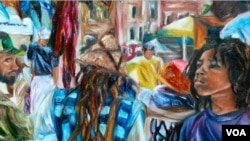One of the reasons I got into journalism (many years ago!) was for the opportunity to meet some of the most interesting and inspiring people… and through them, learn more about the history and culture of my adopted country.
Jeromyah Jones and his father, Jerome Jones, Jr., are among those people.
Both father and son are artists who have created hundreds of paintings, mostly portraits of notable African Americans who’ve made a lasting contribution to American culture. They created a banner, called “I AM 400,” which uses 69 of those paintings to commemorate the 400th anniversary of the arrival of the first enslaved Africans in colonial North America.
While I consider myself pretty well- informed about the history of slavery in America, it still shocks to me to learn that a country widely regarded as a shining beacon to all who travel here has such a long and brutal history, dating from its earliest days.
Like many others, I’ve read history books, seen films and documentaries, and heard many personal stories about the countless atrocities committed against the hundreds of thousands of Africans who were kidnapped, brought to these shores against their will, and sold into slavery for the economic enrichment of white men. It was, for so very many, a torturous existence.
Seeing the Joneses’ artistic depictions of that experience -- from idyllic scenes of the motherland, to the imagined stench of slave ships overflowing with starving, sick and chain-bound men, to the unimaginable horrors of slavery -- brought it all home.
But as is the case with so many stories of immeasurable pain and suffering, the paintings also highlight the good, representing in colorful images the stories of the many who were able to overcome the odds and survive the hardships, to “not only survive, but thrive,” as Jerome Jones, Jr., put it.
Looking at those African American faces of prominent lawmakers, tennis pros, musicians, poets, writers, artists -- many very familiar to us and others less so but who still had a story of survival to share -- was both a humbling and awe-inspiring experience.
“We wanted to paint the journey, not only the struggles, but also the successes, as descendants of Africans who were enslaved in 1619,” Jeromyah Jones said.
During our visit to the Black History Museum in Richmond, Virginia, where the exhibit was displayed, I also learned something else … the meaning of the word Juneteenth. It is, as I’ve come to understand, one of the oldest celebrations commemorating the ending of slavery in the United States, dating back to 1865.
I know that now, thanks to Adele Johnson, executive director of the museum, whom I met and interviewed. I am glad to finally understand the meaning of that word, but am also somewhat chagrined to be learning about it only now… after almost 40 of living in America.
Sadly, I’m not the only one. “The average American does not know about the 400-year history,” Johnson told me.
Here’s how she described it:
“It was on June 19 that the Union soldiers finally came to Galveston, Texas with the news that the enslaved were now free. But that was two and a half years after Lincoln's Emancipation Proclamation. So there's a story that's often told about a messenger that was murdered along the way to Texas as he was trying to share the news of freedom. There's also another story that says it was deliberately withheld by the enslavers to maintain the labor force of the plantations. And still another story about federal troops actually waiting for the slave owners to finish reaping the benefits from the last cut and harvest.”
“So we don't know which of these stories is true or whether or not they're true. But it's very fitting that we celebrate it, because as we know it, that was the end of slavery. And that's something that we all need to recognize.”
I feel blessed to have a job where I am not only learning new things that help inform my own life, but one that also provides me the tools and opportunities to create stories around those experiences and share them with our VOA audience. I feel I am doing my small part in helping to tell America’s story.






